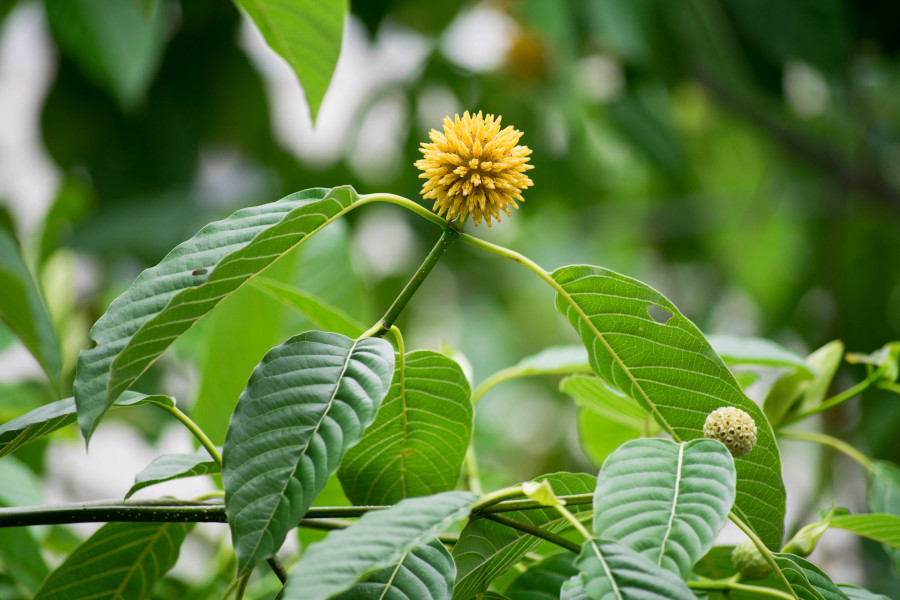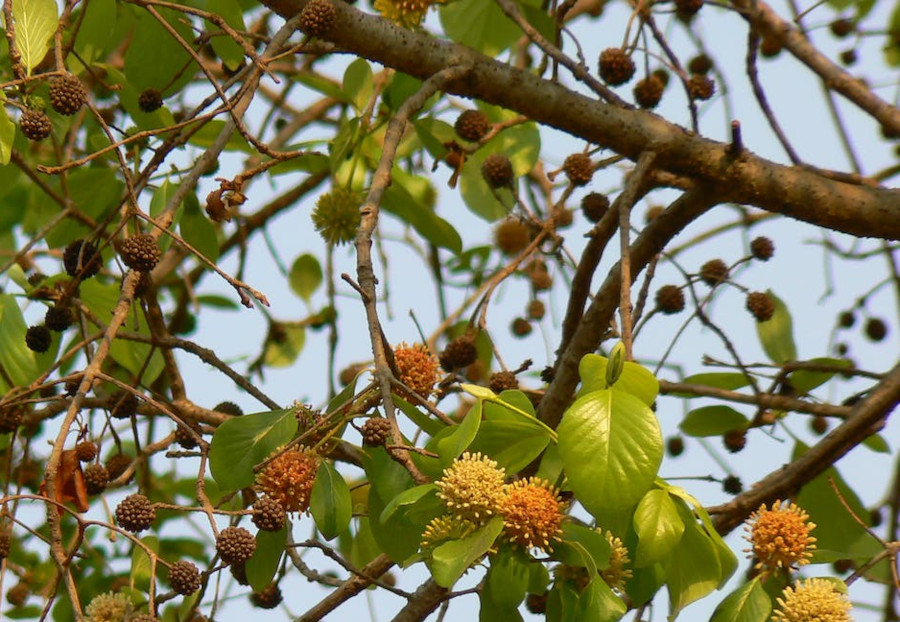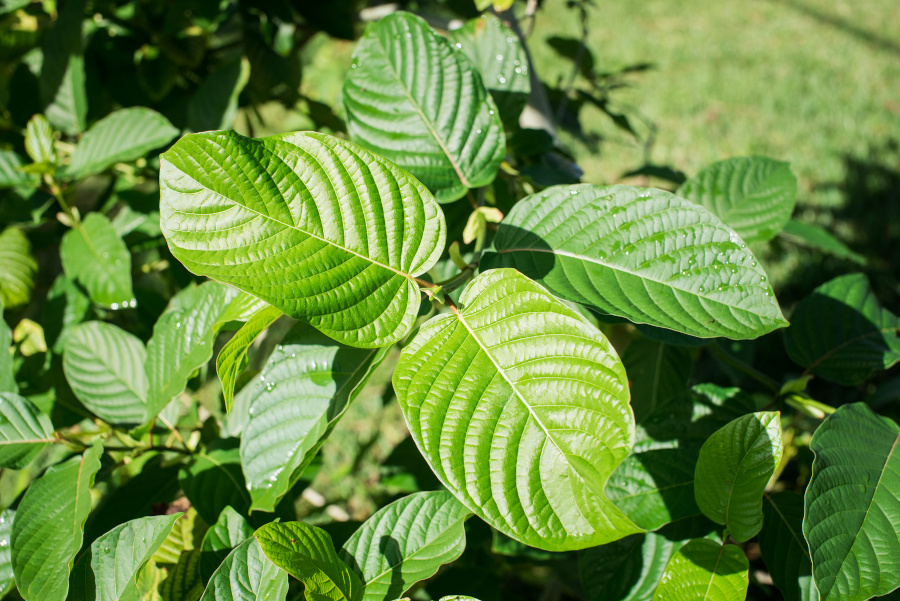Overview
Scientific name: Mitragyna speciosa
Other names: Kratom is also known by various other names, including Biak-Biak, Kratum, Kakuam, Ithang, and Thom.
Family: Rubiaceae
Habitat: Kratom is a tropical evergreen tree native to Southeast Asia. It is found primarily in countries like Thailand, Indonesia, Malaysia, and Papua New Guinea. Kratom trees typically grow in marshy areas and near rivers or streams.
Is this a natural or wild species?:
Yes, kratom (Mitragyna speciosa) is a natural wild species found in the rainforests of Southeast Asia. It is a tropical evergreen tree native to the rainforests of Southeast Asia, particularly in countries such as Thailand, Indonesia, Malaysia, and Papua New Guinea.
In its native regions, kratom can be found growing in the wild, typically in marshy areas and near rivers or streams. The tree can reach heights of up to 80 feet (about 24 meters) and has dark green glossy leaves with a characteristic oval shape.
For centuries, indigenous communities in Southeast Asia have used kratom leaves for their medicinal and recreational properties. The leaves are traditionally chewed, brewed into teas, or used in various herbal preparations. The active compounds in kratom, such as mitragynine and 7-hydroxymitragynine, interact with the body’s opioid receptors, leading to a range of effects that can include pain relief, relaxation, and mood enhancement.
In recent years, kratom’s popularity has grown outside of its native region, leading to concerns about its potential risks and benefits in various parts of the world. As a result, the cultivation and use of kratom have become more regulated and controlled in some countries.
It’s important to note that the status of kratom, both in terms of legality and acceptance, can vary widely depending on the country or region. As with any plant or substance, sustainable harvesting and responsible use are essential to preserve wild populations and mitigate potential environmental and social impacts.
Brief description:
Kratom trees can reach heights of up to 80 feet (about 24 meters) and have dark green glossy leaves with an oval shape. The leaves contain several active compounds, with mitragynine and 7-hydroxymitragynine being the most significant, responsible for the plant’s potential effects.
How many varieties of kratom exists?
The classification of kratom strains is primarily based on the region where the kratom is grown, as well as the colour of the veins on the leaves. The main kratom strains are typically categorised as follows:
- Red Vein Kratom: This strain has red-coloured veins and is often associated with relaxing and pain-relieving effects. It is commonly used by individuals seeking relief from chronic pain or to promote relaxation and better sleep.
- Green Vein Kratom: Green vein kratom has green-coloured veins and is believed to have a more balanced effect, combining both stimulating and pain-relieving properties. It is often used for increased energy, focus, and mood enhancement.
- White Vein Kratom: White vein kratom has white-coloured veins and is known for its stimulating and energising effects. It is often used by individuals seeking a boost in energy, focus, and productivity.
- Yellow Vein Kratom: Yellow vein kratom is rarer and less commonly found than the other strains. It is believed to be a blend of different vein colours or a result of a unique drying process. The effects may vary depending on the specific batch or source.
Within each of these main strains, there can be further variations and sub-strains based on the specific region where the kratom is grown and the conditions of cultivation. Different regions in Southeast Asia, such as Bali, Borneo, Maeng Da, Malay, and Thai, are often associated with specific kratom strains.
It’s important to note that the classification of kratom strains can be somewhat subjective, and the effects of different strains can vary from person to person. The variability in alkaloid content and other factors makes it challenging to standardise the effects of specific strains.
Additionally, the kratom market is dynamic, and new strains or marketing names may emerge over time. It’s essential to obtain kratom products from reputable sources and exercise caution when trying new strains.

Medicinal parts:
In traditional medicine practices, different parts of the kratom tree (Mitragyna speciosa) have been used for various medicinal purposes. The most commonly utilised part is the leaves, which contain the active compounds (alkaloids) responsible for kratom’s potential effects. Here are the parts of kratom used medicinally:
- Kratom Leaves: The leaves of the kratom tree are the most widely used part for medicinal purposes. They contain active alkaloids, such as mitragynine and 7-hydroxymitragynine, which interact with the body’s opioid receptors and may produce effects like pain relief, relaxation, and mood enhancement. The leaves can be chewed in their fresh form or dried and crushed to make kratom powder, which is used for brewing tea or consumed in other ways.
- Kratom Extracts: In addition to using whole or powdered leaves, kratom extracts are sometimes made to concentrate the active compounds. These extracts can be more potent and are often used in smaller amounts.
- Kratom Resin: Kratom resin is a concentrated form of kratom made by boiling down the leaves into a thick, sticky substance. It is typically added to hot water to dissolve and then consumed.
- Kratom Tea: One of the most common traditional preparations is kratom tea. Dried and powdered kratom leaves are steeped in hot water to make a tea, which is then consumed for its potential medicinal effects.
- Kratom Capsules: Kratom is also available in the form of capsules, where the powdered leaves are encapsulated for easier consumption.
- Kratom Topicals: In some traditional practices, kratom leaves may be applied topically to wounds or skin conditions to promote healing.
Actions:
Kratom’s actions are attributed to the presence of alkaloids, especially mitragynine and 7-hydroxymitragynine. These compounds interact with the brain’s opioid receptors, leading to effects that can include pain relief, relaxation, and mood enhancement. The plant’s action can vary based on the strain and dosage used, as well as individual sensitivity.
Traditional uses:
Kratom has a long history of traditional medicinal use in Southeast Asia. Some of the traditional uses include:
- Pain relief
- Management of diarrhoea
- Energy and stimulation
- Wound healing
- Management of opioid withdrawal
Principal or main uses: The principal uses of kratom traditionally revolve around its potential analgesic and stimulant properties.
Other uses: In addition to its medicinal uses, kratom is sometimes used recreationally or socially, similar to how people in other cultures consume coffee or tea.
Uses in different countries or parts of the world:
While kratom’s traditional use is deeply rooted in Southeast Asia, its popularity has grown in other parts of the world. In some Western countries, people have explored its potential as an alternative to prescription opioids, for managing pain, or for coping with opioid withdrawal symptoms. However, it’s important to note that the legal status and acceptance of kratom can vary widely between countries and regions.
Preparation and dosage:
Kratom can be prepared as a tea by boiling kratom leaves or powder in water. The dosage of kratom can vary depending on factors such as the user’s tolerance, age, weight, and the specific strain or preparation used. Typical dosages are in the range of 2 to 6 grams of kratom powder.
Herbal formulas or recipes:
Kratom is commonly prepared as kratom tea, but it can also be found in various forms such as capsules, extracts, and tinctures. In traditional Southeast Asian practices, fresh leaves are chewed or used in food preparations.
Kratom tea recipes
Making kratom tea is one of the traditional ways to consume kratom. Here are a few simple kratom tea recipes you can try:
Basic Kratom Tea:
Ingredients:
- 2 to 4 grams of kratom powder
- 2 cups of water
Instructions:
- Bring the water to a boil in a pot.
- Add the kratom powder to the boiling water.
- Reduce the heat to a simmer and let the mixture brew for about 10 to 15 minutes.
- Stir the tea occasionally during the simmering process.
- After simmering, remove the pot from the heat and let the tea cool slightly.
- Strain the tea through a fine sieve or a piece of cloth to remove the kratom powder.
- Serve the tea in a cup and enjoy.
Enhanced Kratom Tea:
Ingredients:
- 4 to 6 grams of kratom powder
- 2 cups of water
- 1 to 2 teaspoons of lime or lemon juice (optional, may enhance alkaloid extraction)
- Honey or sweetener of your choice (optional, to improve taste)
Instructions:
- In a pot, combine the water and lime or lemon juice (if using) and bring it to a boil.
- Add the kratom powder to the boiling water.
- Reduce the heat to a simmer and let the mixture brew for about 15 to 20 minutes.
- Stir the tea occasionally during the simmering process.
- After simmering, remove the pot from the heat and let the tea cool slightly.
- Strain the tea through a fine sieve or a piece of cloth to remove the kratom powder.
- If desired, add honey or your preferred sweetener to improve the taste.
- Serve the tea in a cup and enjoy.
Kratom Chai Tea:
Ingredients:
- 2 cups of water
- 1 cup of plant-based milk
- 2 to 4 grams of kratom powder
- 1 cinnamon stick
- 3 to 4 cardamom pods
- 3 to 4 cloves
- 1-inch piece of fresh ginger, sliced
- Honey or sweetener of your choice (optional, to taste)
Instructions:
- In a pot, combine the water, plant-based milk, and all the spices (cinnamon stick, cardamom pods, cloves, and ginger).
- Bring the mixture to a simmer, and let it infuse for about 10 minutes on low heat.
- Add the kratom powder to the pot and continue to simmer for an additional 10 to 15 minutes.
- Stir the mixture occasionally during the simmering process.
- After simmering, remove the pot from the heat and let the tea cool slightly.
- Strain the tea through a fine sieve or a piece of cloth to remove the spices and kratom powder.
- If desired, add honey or your preferred sweetener to improve the taste.
- Serve the kratom chai tea in a cup and enjoy.
Individual sensitivity to kratom can vary, so it’s best to start with a lower dosage and gradually increase if needed. Additionally, be cautious about using kratom in combination with other substances or medications.

Scientific research:
Kratom has garnered increasing interest in the scientific community, and there is ongoing research exploring its potential medicinal properties. Some studies have looked into its potential as an analgesic, for opioid withdrawal management, and its impact on the body’s opioid receptors. The plant’s popularity and controversial status have spurred interest in understanding its potential benefits and risks. Here is an analysis of the existing research on kratom:
- Pain Relief and Analgesic Properties: Several studies have investigated kratom’s potential as an analgesic, particularly for managing chronic pain. Some animal studies and anecdotal evidence suggest that kratom may have pain-relieving effects, likely mediated through its interaction with the body’s opioid receptors.
- Opioid Withdrawal Management: One of the most well-known traditional uses of kratom is for managing opioid withdrawal symptoms. Some research and user reports suggest that kratom may help alleviate withdrawal symptoms and reduce cravings associated with opioid dependence. However, evidence from controlled clinical trials is still limited, and the safety and effectiveness of kratom for this purpose require further investigation.
- Impact on Opioid Receptors: Kratom’s active compounds, mitragynine, and 7-hydroxymitragynine, interact with the body’s opioid receptors. Research has explored the pharmacology of these alkaloids and their effects on different opioid receptors in the brain and body. Understanding these interactions may provide insights into kratom’s potential therapeutic applications and risks.
- Adverse Effects and Toxicity: Some studies have documented cases of adverse effects related to kratom use, including nausea, vomiting, constipation, dizziness, and liver toxicity.
- Pharmacokinetics and Metabolism: Studies have explored the absorption, distribution, metabolism, and excretion of kratom alkaloids in humans and animals. Understanding these pharmacokinetic properties is essential for determining appropriate dosages and potential drug interactions.
- Potential for Abuse and Addiction: Some research has suggested that kratom may have addictive potential, and there have been reports of individuals developing dependence on the plant.
- Interaction with Other Substances and Medications: Kratom’s alkaloids can interact with other drugs and medications, potentially leading to adverse effects or altered pharmacokinetics.
- Variability in Kratom Strains: Different kratom strains may have varying alkaloid profiles, leading to differing effects. Research on the chemical composition and pharmacological properties of various kratom strains can provide valuable insights for users seeking specific effects.
- Regulatory and Legal Considerations: Research on kratom’s potential risks and benefits can inform policymakers and regulatory agencies in their decisions about its legal status and appropriate regulation.
It’s important to note that research on kratom is complex due to its variable alkaloid content, potential for contamination, and challenges associated with conducting controlled studies on a substance with varying legal statuses around the world.
Cautions:
While kratom has been used traditionally, it is not without controversy. There are potential risks associated with its use, including dependence, addiction, and withdrawal symptoms. Some reports have linked kratom consumption to adverse effects, including liver toxicity, respiratory issues, and other health concerns. Kratom may also interact with other medications, so caution should be exercised when combining it with other substances.
Side-effects and Contraindications:
Some of the potential side effects of kratom use may include nausea, vomiting, constipation, dry mouth, and increased urination. Long-term and excessive use may lead to more serious side effects, including addiction and withdrawal symptoms. Individuals with pre-existing medical conditions, especially liver or kidney disorders, should be cautious about using kratom. Pregnant or nursing women should also avoid kratom due to the lack of safety data in these populations.
References:
– Singh D, Müller CP, Vicknasingam BK. Kratom (Mitragyna speciosa) dependence, withdrawal symptoms, and craving in regular users. Drug Alcohol Depend. 2014;139:132-137.
– Prozialeck WC, Jivan JK, Andurkar SV. Pharmacology of Kratom: An Emerging Botanical Agent With Stimulant, Analgesic and Opioid-Like Effects. J Am Osteopath Assoc. 2012;112(12):792-799.
– National Institute on Drug Abuse (NIDA). Kratom DrugFacts. Revised October 2020. Accessed on 15th July 2023: https://www.drugabuse.gov/publications/drugfacts/kratom
– U.S. Food and Drug Administration (FDA). Statement from FDA Commissioner Scott Gottlieb, M.D., on the agency’s scientific evidence on the presence of opioid compounds in kratom, underscoring its potential for abuse. FDA News Release. 2018. Accessed on 15th July 2023: https://www.fda.gov/news-events/press-announcements/statement-fda-commissioner-scott-gottlieb-md-agencys-scientific-evidence-presence-opioid-compounds
– Roche BM, Frederick-McGlathery ML, Elstner KE. Kratom Use and Toxicities in the United States. J Med Toxicol. 2021;17(3):263-268.
This article is copyrighted by Ital is Vital, 2025. Want to re-post this article? Visit our guidelines.
DISCLAIMER: THIS WEBSITE DOES NOT PROVIDE MEDICAL ADVICE
The information, including but not limited to, text, graphics, images and other material contained on this website are for informational purposes only. The purpose of this website is to promote broad consumer understanding and knowledge of various health topics. It is not intended to be a substitute for professional medical advice, diagnosis or treatment. Always seek the advice of your physician or other qualified health care provider with any questions you may have regarding a medical condition or treatment and before undertaking a new health care regimen, and never disregard professional medical advice or delay in seeking it because of something you have read on this website.
